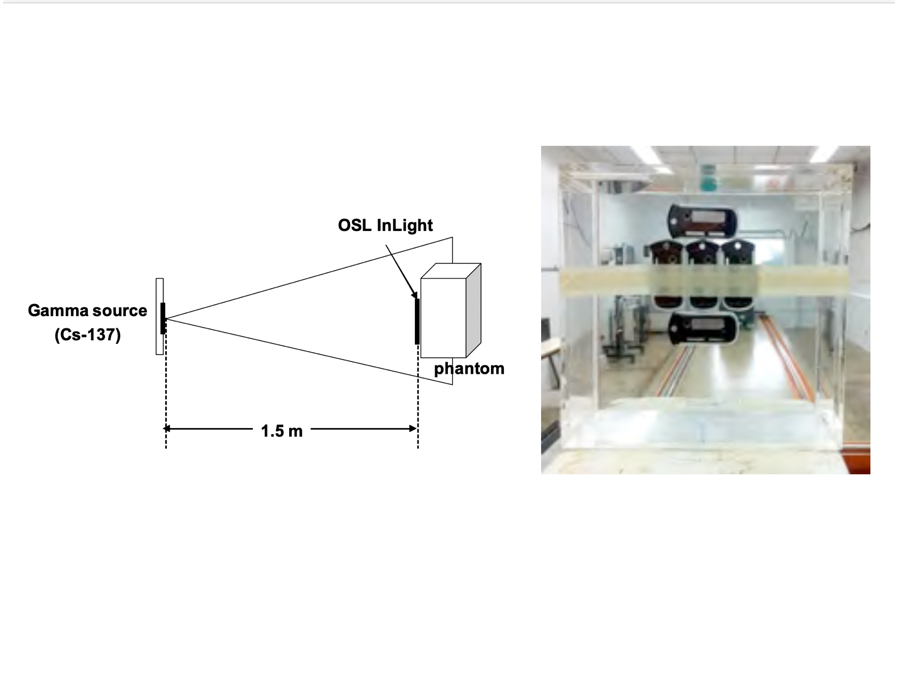Radiation dose response of InLight® optically stimulated luminescence (OSL) dosimeter
Keywords:
Optically Stimulated Luminescence dosimeter (InLight), Radiation dose response, water phantomAbstract
Introduction: Optically stimulated luminescence (OSL) dosimeter has been widely used for personal radiation dosimeter. The radiation dose is recorded and compared with the dose limitation in order to monitor risk from working with radiation. Therefore, the efficiency of personal OSL dosimeter is importantly concerned. Objective: The purpose of this study is to define the efficiency of InLight® OSL dosimeter by comparing with the standard radiation source of the x-rays (x-rays tube), beta rays (Strontium-90) and gamma rays (Cesium-137). The radiation dose responses of OSL dosimeter were studies where the findings can be used for differentiating the types and energy of radiation. Materials and methods: InLight® OSL were placed on the phantom and irradiated with three different radiation sources which were x-ray from x-ray tube, beta from Sr-90 and gamma ray from Cs-137 with different mean energy range between 33 - 662 keV and varying the radiation dose of 0.2 mSv, 2.0 mSv and 5.0 mSv. The standard radiation source is placed at an angle of 90 degrees with the OSL dosimeter. Results: The efficiency of OSL dosimeter depends on the type, dose, and energy of radiations. OSL dosimeter was poorly response to the low radiation dose (0.2 mSv) from x-ray and beta with the measurement error of 28% and 74%, respectively. The x-ray standard graph of OSL can be used to distinguish the energy of x-ray however; it cannot differentiate the x-ray radiation dose. The differences of beta and gamma ray standard graph can be used to distinguish the types of radiation. Conclusion: The use of OSL dosimeter to analyze the type, dose, and energy of radiations requires the standard graphs and radiation dose responses. The different types of radiation such as x-ray, beta, and gamma including the dose and energy of radiation must be examined before measuring the dose received from radiation workers. The angle of radiation source and dosimeter must also be concerned.
Downloads
References
Mettler FA. Medical effects and risks of exposure to ionising radiation. J Radiol Prot 2012; 32(1): 9-13.
Wagner LK, Eifel PJ, Geise RA. Potential Biological Effects Following High X-ray Dose Interventional Procedures. J Vasc Interv Radiol 1994; 5(1): 71-84.
ราชกิจจานุเบกษา. พระราชบัญญัติพลังงานนิวเคลียร์ พ.ศ.๒๕๕๙. [อินเตอร์เน็ต] [เข้าถึงเมื่อ ๑๒ ธ.ค. ๒๕๕๙] เข้าถึงได้จาก; http://www.oap.go.th/images/documents/about-us/regulations/nuclear-energy-act-2559.PDF.
Sudjai W. Inlight optically stimulated luminescence for occupational monitoring service in Thailand. Bull Dept Med Sci 2012; 54(2): 110-116.
Agyingi EO, Mobit PN, Sandison GA. Energy response of an aluminium oxide detector in kilovoltage and megavoltage photon beams: an EGSnrc Monte Carlo simulation study. Radiat Prot Dosimetry 2006; 118(1): 28-31.
McKeever SWS, Akselrod MS. Radiation dosimetry using pulsed optically stimulated luminescence of Al2O3:C. Radiat Prot Dosimetry 1999; 84(1-4): 317-320.
Bauhs JA, Vrieze TJ, Primak AN, Bruesewitz MR, McCollough CH. CT dosimetry: comparison of measurement techniques and devices. Radiographics 2008; 28(1): 245-253.
Landauer Inc. Dosimeters: InLight® Systems Dosimeters. [Internet]. 2005. [cited 2017 May 20]. Available from: https://www.nagase-landauer.co.jp/english/inlight/pdf/Dosimeters/inlightdosimeters.pdf
ยุทธนา บางม่วง, วราภรณ์ สุดใจ. การสำรวจปริมาณรังสีพื้นหลังของประเทศโดยใช้แผ่นวัดรังสีชนิดโอเอสแอล. วารสารกรมวิทยาศาสตร์การแพทย์. ๒๕๕๖;๕๕:๓๑-๓๘.

Downloads
Published
How to Cite
Issue
Section
License
บทความที่ได้รับการตีพิมพ์เป็นลิขสิทธิ์ของสมาคมรังสีเทคนิคแห่งประเทศไทย (The Thai Society of Radiological Technologists)
ข้อความที่ปรากฏในบทความแต่ละเรื่องในวารสารวิชาการเล่มนี้เป็นความคิดเห็นส่วนตัวของผู้เขียนแต่ละท่านไม่เกี่ยวข้องกับสมาคมรังสีเทคนิคแห่งประเทศไทยและบุคคลากรท่านอื่น ๆในสมาคม ฯ แต่อย่างใด ความรับผิดชอบองค์ประกอบทั้งหมดของบทความแต่ละเรื่องเป็นของผู้เขียนแต่ละท่าน หากมีความผิดพลาดใดๆ ผู้เขียนแต่ละท่านจะรับผิดชอบบทความของตนเองแต่ผู้เดียว




